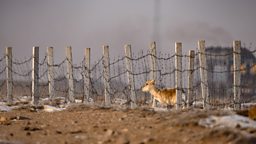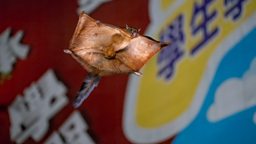Purple frog: the most critical night
By Sugandhi Gadadhar, Cinematographer

The purple frog is something of a mystery. It was only formally described in 2003, and not much is known about its behaviour – primarily because it lives almost entirely underground. What little we do know about purple frogs comes from the brief period at the onset of the rainy season, when pairs emerge on the surface to breed. But this happens just once a year, for only a few hours.
The purple frog is something of a mystery.
The female, carrying eggs in her belly and her much smaller mate on her back, crawls towards the nearest forest stream and lays her eggs in a tight crevice with just the right amount of water flowing through it. We aimed to film the laborious, dangerous journey of a mating pair, whose sole mission is to lay eggs and then return to their underground refuge.
This is easier said than done. Frogs can appear from anywhere, and once on the forest floor, the female crawls determinedly straight to the streams. Once she lays her eggs and the male fertilizes them, they disappear underground. Our team would have just a few hours to film them, and to say that we would need lots of luck would be an understatement.
Knowing that our filming window would be brief, we built our strategy around trying to predict the frogs’ movements. How they gauge the right conditions to emerge from below the ground still remains to be understood. As we grappled with the uncertainty of both the timing and the location of the emergence, we realised we would have to rush from stream to stream, checking for calls and combing the jungle for the frogs. Most worryingly, our initial observations showed that the maximum number of calls occurred during the heaviest of rains, the worst conditions imaginable for sensitive camera equipment and lights. Could anything be more challenging?

In our first filming season, Dr Sandeep Das and his team, who have been studying purple frogs for several years, had already been on the ground for a few weeks across different locations in Kerala, south India, monitoring the rains and breeding streams. The frogs usually emerge around the middle or end of May. But in this particular year, a cyclone hit southern India, causing a deluge of rain almost a month before the purple frog’s emergence usually occurs. The camera crew was still travelling to the location when Sandeep called to say that the breeding had come and gone – it was all over in just that one night, such was the intensity of the rains.
...it was all over in just that one night...
Hopes that we could focus on another site were also soon dashed. Everything happened simultaneously within a day or two across all the breeding sites Sandeep’s team monitored. With everything done both for us and the frogs, we had no choice but to wait until the following year and try again.
Next time, all of us - camera crew and researchers - decided to be better prepared, and were on location a month before the rains were due. Again, the rains began sooner than expected. With the first shower, the calls of the male purple frogs began, “Korakok, korakok, korakok…”, with the chorus slowly increasing in intensity and volume. Everyone waited with bated breath. The males would need to show off their calls for a few days, then the females would emerge, and it would be our night!

But then, just like that, the rains stopped. No rain, no calls. Once every few days, it would rain for a few minutes – and then it would be dry again with clear blue skies. Nidheesh, a naturalist on Sandeep’s team, became so frustrated with the weather forecast not matching reality that he threatened to throw his phone away! Every night, we would go into the forests and wait – there wasn’t a single frog of any species in sight, let alone a purple frog. We had nothing whatsoever to film.
But then, just like that, the rains stopped.
For a story set in torrentially wet jungles, it felt surreal looking out in daylight at the bone-dry landscape. One of the housekeeping staff in the hotel would head out to gather supplies occasionally. Every time he started up his Royal Enfield Bullet motorcycle, all of us would run out into the yard, hoping we had heard thunder. We would return dejected.
As the parched weather persisted, a bigger problem arose – elephants. With the absence of rain, the streams where the purple frogs breed had become a critical water source for the herds. For us, elephants presented too great a danger to risk entering the forest. On several nights, we were either roadblocked by elephants or had to pack up and leave because we heard or smelled them very close. Once, we returned to our hotel to see the boundary wall knocked down – the elephants wanted to get to the water inside.

After over forty days of waiting, we ran out of time and budget. We were all set to pack up and leave on the last day of the shoot, when suddenly, it started raining! Water poured down throughout the night. Sandeep and his team checked every crevice with no luck. The volume of rain was apparently too high for the purple frogs to emerge. But then, out of the blue, Sandeep’s voice cut through the night air: “Purple frog!” And just like that, the pairs began to emerge – females with males on their backs.
...suddenly, it started raining!
We used two cameras, with lenses of different focal lengths, so we could film as much as possible in such a time-critical situation. The two camera operators, Rana and I, filmed the frogs with Sandeep’s team of Nidheesh, Jishnu, and Amrit, who helped with lights and guided us with the frogs. We literally filmed on waterfalls in the pouring rain, being careful not to slide or fall onto anything crawling or hopping.
In the end, our filming trip was a success. But for the frogs, it did not end so well. The heavy rains that happened that night were a one-off. The year turned out to be a drought, with severe water scarcity in southern India. The research team continued to monitor the eggs, only to find that a lack of flowing water killed most of them. With this drought affecting Year Two, and the deluge washing away the eggs in Year One, the team witnessed and experienced the effects of an unpredictable climate on the purple frog.

The monsoon quest of the purple frog
A rare purple frog and her mate brave monsoon torrents to find shelter and lay eggs.



































